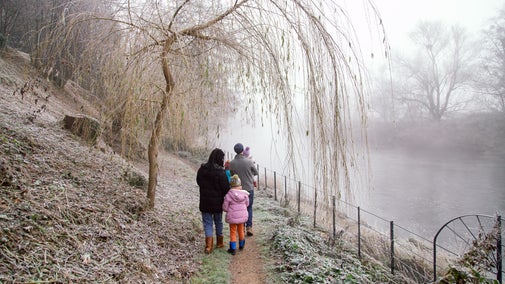Hambleden Mill to Henley-on-Thames circular river walk
Oxfordshire, Buckinghamshire & Berkshire
This circular walk starts at the site of a Roman villa complex, then crosses the River Thames via a weir and lock at Hambleden Mill, before heading upstream alongside the regatta course to Henley-on-Thames. A low hill above Remenham offers panoramic views across the Thames Valley, and on the final quiet stretch of river there's a chance of spotting kingfishers.
Near to
Chilterns CountrysideStart point
Public car park in Skirmett Road, Mill End, Hambleden, grid ref SU 785854Trail information
Thames Path closures
After long periods of heavy rain, parts of the route may flood. Please check with the Environment Agency before starting your walk. Before and during Henley Regatta week, the path there may be temporarily closed. During the festival itself, a 488m stretch is closed. There is a parallel route nearby.
More near here
Hambleden and Pheasant’s Hill trail
Visit rural hamlets, stroll through beech woods and enjoy views across the Hambleden Valley on the Hambleden and Pheasant’s Hill trail.

Chiltern Hills three-in-one walk
Discover a challenging 8½-mile scenic walk linking three National Trust places in the Chiltern Hills: West Wycombe, Bradenham and Hughenden. Longer and shorter routes can be completed depending on your choice.

Watlington Hill short walk
This walk offers memorable views over the Vale of Oxford and Chiltern Escarpment, as well as abundant wildlife and birdlife amongst the site's chalk grassland and woodland habitats.

Bradenham beech woods walk
Enjoy a classic Chilterns landscape and find out more about the history of this part of the world on the Bradenham beech woods walk.

Get in touch
Chilterns Countryside, c/o Hughenden estate, High Wycombe, Buckinghamshire, HP14 4LA
Our partners

We’ve partnered with Cotswold Outdoor to help everyone make the most of their time outdoors in the places we care for.
You might also be interested in
Cotswold Outdoor: our exclusive walking partner
Learn about the National Trust’s ongoing partnership with Cotswold Outdoor. Find out how they help us care for precious places and the exclusive discount available for National Trust supporters.

Things to see and do in the Chilterns Countryside
Discover the countryside sites of the Chilterns. Find the best viewpoints, walk through ancient woodland or pick a quiet spot to watch for wildlife.

Visiting Aston Wood and Juniper Bank in the Chilterns Countryside
Discover Aston Wood and Juniper Bank in the Chiltern Hills. These woodland sites are ripe for exploring, with wildlife to spot and trails to follow.

Visiting Bradenham in the Chilterns Countryside
Discover scenic Bradenham. Look for wildlife and hidden archaeology in the ancient woodland or set out to explore the picturesque village.

Visiting Coombe Hill in the Chilterns Countryside
Explore the walking trails, play area and wildlife of Coombe Hill, the highest point in the Chiltern Hills.

Things to see at Pulpit Hill Iron Age fort in the Chilterns Countryside
Explore the ancient remains of a hidden Iron Age hillfort in this atmospheric woodland.

Visiting Watlington Hill in the Chilterns Countryside
The wonderful views, rich chalk grassland and downland of Watlington Hill make it a perfect place for walks and wildlife spotting.

Walking in Oxfordshire, Buckinghamshire and Berkshire
From gentle strolls for little legs to longer hikes through the rolling Chiltern hills, these are some of the best walks in Oxfordshire, Buckinghamshire and Berkshire.




